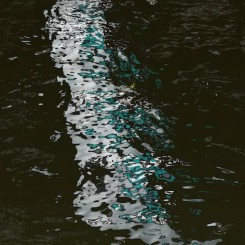Gagosian Gallery (7/F Pedder Building, 12 Pedder Street, Central, Hong Kong). May 15–Jun 16, 2012.
One of the most important artists working in photography today, and a famously errant pupil of the Ernst and Hilla Becher school of German photography, Andreas Gursky’s subtly manipulated and densely rich images, often large scale, have helped transform photography into a highly synthetic and conceptual art form. Iconic images, such as “Chicago, Board of Trade II” (1999), mesh reality (time and action) and “all-over” Pollockian abstraction in ways that play on received knowledge and expectation regarding (photographic) reality, while simultaneously seducing with fascinating detail and luscious color saturation.
This exhibition mixes older works (“99 Cent II,” 2001, and “Kathedrale,” 2007 — in which the film-director Wim Wenders has a tiny cameo), including small-scale versions of certain works (“Shanghai Bank,” 1994, and “Bahrain 1,” 2007, and “Pyongyang IV,” 2007 — reducing the grandiose and megalomaniac to something manageable, like swapping a city for an ant-farm). This is helpful for an historical context, particularly for Gursky’s first exhibition in Asia, but I would personally have preferred to see the new works of Bangkok’s Chao Praya River in isolation, which would have helped to understand them as the meditations on abstraction, painting and surface that they are, harking back to the heroic abstract expressionists of the 1950s, including Jackson Pollock, Marc Rothko, and Hans Hoffman, but also to Monet’s Water Lilies series.
The selection of works, large and small, was made by Gursky himself, following the format adopted in his vast “Works 80 – 08” exhibition, which traveled to major museums in 2008–2009 in Krefeld (Germany), Vancouver and Stockholm (Moderna Museet, where M+ Director, Lars Nittve, was then director) and a further exhibition this year at the Louisiana Museum of Modern Art in Copenhagen 2011–12. The scale of these exhibitions meant it was impossible to include all the works in their original formats but it presented Gursky with an opportunity to consider the relationship between photographic and pictorial scale and genre by mixing large-scale works with almost “book-sized” versions of other, already renowned, large works, such as “Pyongyang IV.” Born of necessity, it thus became a curatorial device to consider these issues, particularly apropos Hong Kong/Asia, and also the Gagosian’s exhibition rooms themselves (inevitably small compared with airy museum halls, and which in some respects condensed the experience of the works — especially on a crowded opening night). Accordingly, the small-scale works are never for sale but exhibition copies only.
Gagosian’s exhibition follows Ben Brown Fine Art’s recent survey of German photography, also in the Pedder Building in Hong Kong, which also included work by Gursky. This exhibition was a who’s who of German (and therefore world) photography over the last forty years, including Bernd and Hilla Becher, Thomas Demand, Günther Förg, Candida Höfer, Axel Hütte, Imi Knoebel, Thomas Ruff, Thomas Struth and Wolfgang Tillmans. But crucially it also included artists whose medium is primarily painting but who have used photography as part of their intellectual and methodical process, such as Anselm Kiefer, Sigmar Polke and Gerhard Richter.
The importance of these two exhibitions must be gauged in context with the quite separate development of photographic-based art in China since the 1980s. While there have been exceptions such as Geng Jianyi’s Becher-esque examinations of glass jars (in German, “Becher” means “beaker”), the vast majority of photographic practice has been performance-based, including Ai Weiwei’s Study of Perspective series (1995-2003), Cao Fei’s Cosplayers series (like many such works, tellingly also a video), the Gao Brothers’s political-spatial performances, or the emerging artist Chen Wei’s stagey still-lifes. The emerging exceptions involve a casual photography of the everyday, typified by Birdhead, Zhang Jungang and Li Jie, rather than the formal examinations of their German counterparts.
While the work of artists such as Cindy Sherman has been more or less absorbed, Thomas Ruff remains largely foreign matter (one exception being Xu Zhen’s Super Absorbent series which apparently references Ruff’s pornography derived photographs). But Chinese artists have yet to engage with the importance of German photographers in developing a new conceptual framework for understanding photography as a medium as opposed to simply a device for recording a scene. Some in China would ague that this is not necessary. They are right but the lack of dialogue cheapens understanding and limits the possibility of synthesis. As Michael Fried posits, the new photography, which of course is not only about German photographers, anchors this style of photographic practice in the history of Western art concerned with the internal structure of painting and how we, as viewers, interact with paintings, whether Courbet’s “Burial at Ornan,” Jackson Pollock’s all-over abstracts or the work of minimalist artists of the 1960s and 1970s, such as Donald Judd. That deserves contemplation, regardless of one’s background or personal interests and endeavors.
These two exhibitions will hopefully herald the beginning of a long overdue conversation between Western and Chinese artists about the merits of these quite different approaches. While it does not matter if, in the end, Chinese artists forge completely different paths to their German counterparts, the quality of the conversation does matter. For that to really progress though, exhibitions like these need to travel to Mainland China.
